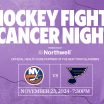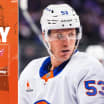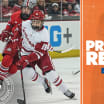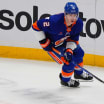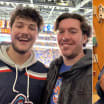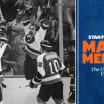It's a quiet August night outside of Hofstra University and the vacant parking lots and empty buildings feel a world away from the New York Islanders-Washington Capitals First Round series.
But inside the studios at WRHU, the Islanders radio broadcast team of Chris King, Greg Picker, and their accompanying producers have established their own little hub.
Satellite Radio
An inside look at how Chris King and Greg Picker are calling Isles playoff games remotely from Hofstra University
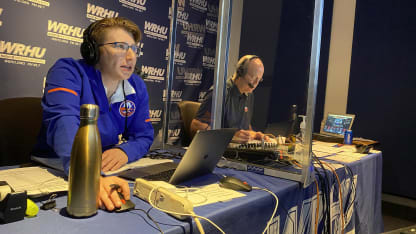
The Long Island studio is where King, the Isles' longtime play-by-play voice, and Picker, the team's full-time color commentator since 2015-16, post up for games, as the NHL bubble is off-limits to fans and local broadcasters.
During games, they sit on opposite sides of a 12-foot long table and watch a pair of 55-inch monitors. Coronavirus policies dictate that they sit with a plexiglass partition between them and only two people are allowed in any room in the studio at a time.
It's an unusual setup, but so is everything during the COVID-19 pandemic. Everyone is sacrificing something to make the NHL's Return to Play work. That includes the broadcasters.
"It's very unusual, but every local broadcaster, radio and TV, is in the same boat we are, that you have to do it remotely," King said. "I think we have a pretty good setup. I do have to bounce between two different 55-inch TV screens that I'm watching, but I'm very close to them, so it feels big and full of life."
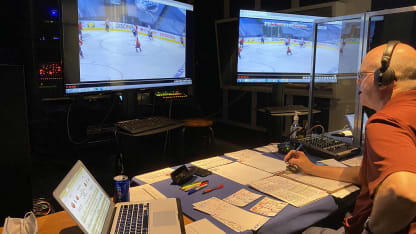
King and Picker watch games in the mixing site, normally used for Facebook Live interviews. They have two feeds of the game, a "clean" feed supplies the audio from the rink, but doesn't have the score and time bugs - which are essential for broadcasters - and the "dirty" feed has the bug, but no audio.
They rely on both to effectively call the game, but also as insurance policies in case there are any issues with the feed from Toronto. A handful of times during the postseason, the feed on one of the monitors has lagged or cut out and Picker had to refresh the feed to sync up - all while providing analysis.
"We have to be a little bit of IT people as well," Picker said. "There is a chance that on one of the feeds, the connection pauses or drops for a moment. I immediately have to go into refresh mode, get it to the right feed and hopefully that second feed is working fine. We can direct our attention to the other monitor for those moments, while we work on the one that goes out. It usually takes about 15-20 seconds, but then we're up and running."
It's an imperfect system, but part of the learning curve for the league and broadcasters alike. In the Isles exhibition win over the Rangers on July 29 the audio was coming in at least five seconds ahead of the video, so fans and broadcasters alike were hearing goal horns before King and Picker were seeing the puck go in on the ice.
The gap is virtually non-existent now and King and Picker commend the NHL for inserting all of the live sounds of a game into the audio feed. The studio space is filled with their voices during the games, but in their headphones, they hear skates scraping the ice, calls for the puck, goal horns and even faux crowd noise. It all helps give the broadcasters a more natural feel for the call.
#Isles defeat the Capitals in 5 games!
— Greg Picker (@GregPickerHere) August 21, 2020
Here is Chris King’s call of the final seconds of the series pic.twitter.com/hoqABkzRXI
"I'll give a lot of credit to the NHL. We could be sitting in a closet and not hearing anything in the background," King said. "They are sending us the sounds of the game: the sticks, the puck, the saves, the glass, the ice, you hear the skates, everything amplified because there's no fans in the building. They're also providing the goal horns, a crowd roar, a refs mic. If someone is just listening and they don't know we're not in the building I have had a lot of friends and family say 'I didn't know you were in Toronto for this game.'"
It still doesn't replace being in the thick of a Coliseum crowd on a playoff game night, but King and Picker manage to keep their energy high during games, especially during King's impassioned goal calls.
"It's just our passion for the Islanders and it's the playoffs," Picker said. "Every single goal, every single moment is so huge, so important."
"What we're missing is that crowd noise, because when you're at the Coliseum and it is the playoffs you have to yell just to hear yourself," Picker added. "It's so loud there. We don't have to do that here in a studio, but it's still the playoffs. It's not the same, but we still get pumped up by seeing a huge goal in a postseason game."
The main challenge for both broadcasters is being limited to the TV feed. In person, King and Picker can watch plays develop, see skirmishes behind the scene and spot ref signals and line changes. Without a full field of vision, there's a little more uncertainty when trying to make quick calls, or assess a changing environment. They also don't have red lights to signal when they are going to a commercial.
Game 1: ✅
— WRHU Radio Hofstra University (@wrhuradio) August 13, 2020
Anytime the @NYIslanders are on the ice, and we make sure that Chris King and @GregPickerHere are on the air!@WRHUSports is safely broadcasting every moment of the playoff series between the #Isles and the Washington Capitals – 88.7FM is the place to hear it all! pic.twitter.com/ebpG0R45tQ
"When you do the game live, you're watching a lot of things away from the puck," King said. "When we have to watch what the camera shows us, that's generally on the puck, so trying to pick up things like a goaltender being pulled in the final minute, we don't see that. A player joining an odd-man rush from behind, a trailing referee calling a penalty, you hear the whistle, but you don't see it… That's been the biggest adjustment for me is trying to find a way to see things that I normally can."
For the WRHU producers, there are pros and cons to the new setup. They enjoy having the broadcasters in studio for communication, but the two-person-per-room policy has forced some improvising, especially since they'd usually have four-to-five producers in a room at one time.
"That's really the main difference, but having Chris and Greg here is really cool," Grant Francis, Lead Producer NY Islanders Radio Network, said. "We work with them throughout the whole season, but now we really work with them in the same building."
"It helps with a little communication too," Francis said. "When you're all in the same building, everybody understands everybody's role a bit better."
While King and Picker miss the atmosphere of being at live games, they also miss the process. King's gameday routine usually involves going to morning skate, noting each team's lines and d-pairings, chatting up the opposing broadcasters for insights and nuggets. Often, the best tidbits come from in-person, or one-on-one chats with players, coaches and staff, so getting those stories has been more challenging over Zoom press conferences. Like the Isles broadcasts on MSG, the radio team also don't have the ability to conduct their own walk-off interviews after periods or games.
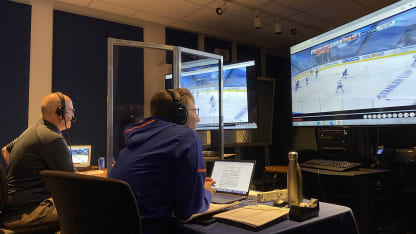
"One of the things I miss the most is just being in the room with the Islanders, being able to sit down next to someone like Anders Lee for an example and just talk hockey," King said. "More than anything else I do professionally, I love game day. So much of game day is taken away because of the current conditions but we have to do what we have to do."
King said the trade-off is spending more time with his family and both broadcasters are grateful to be calling games in any capacity during a pandemic. It may be unusual, but as long as the Isles keep playing into August, they're happy to be along for the ride.





